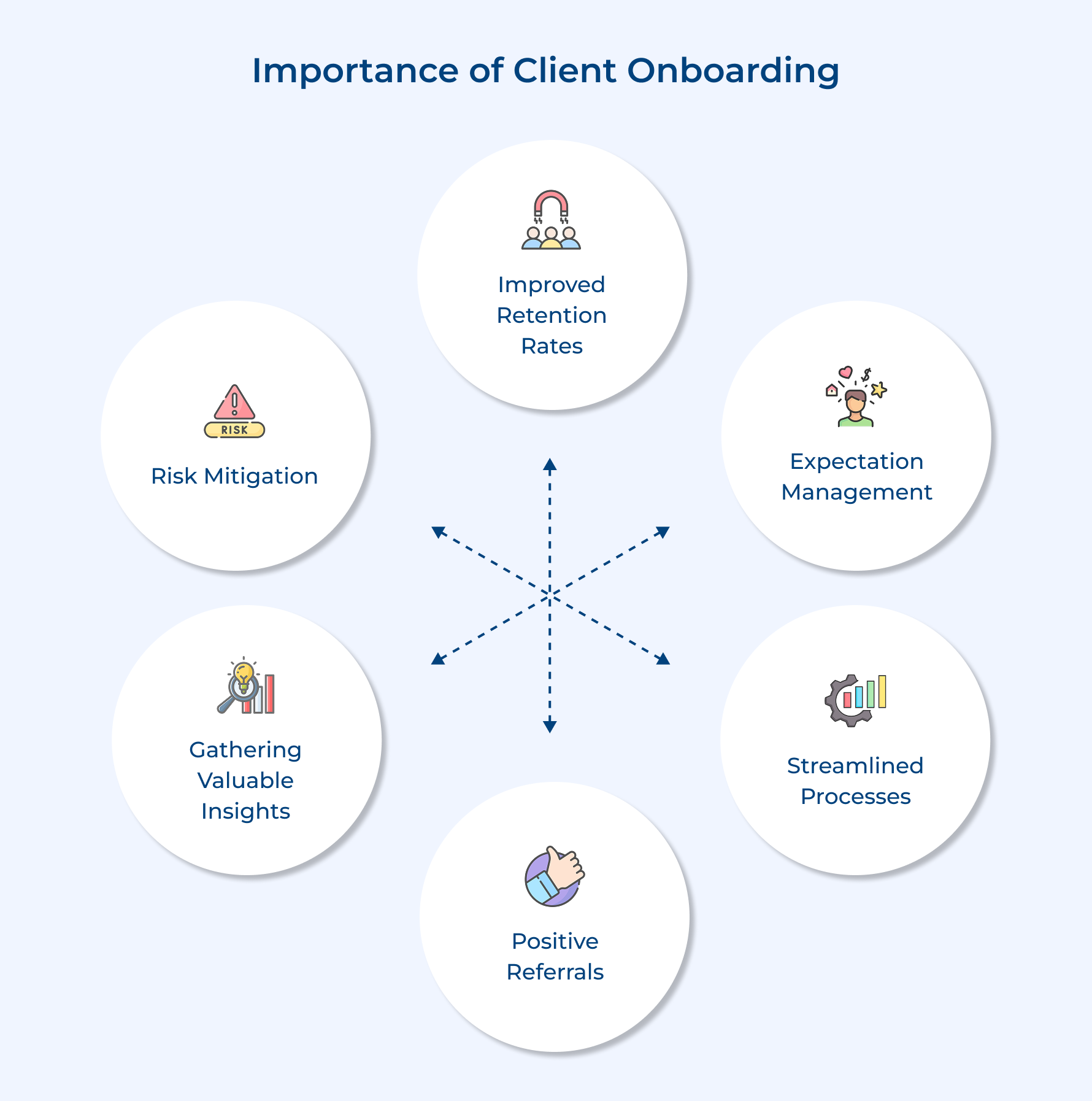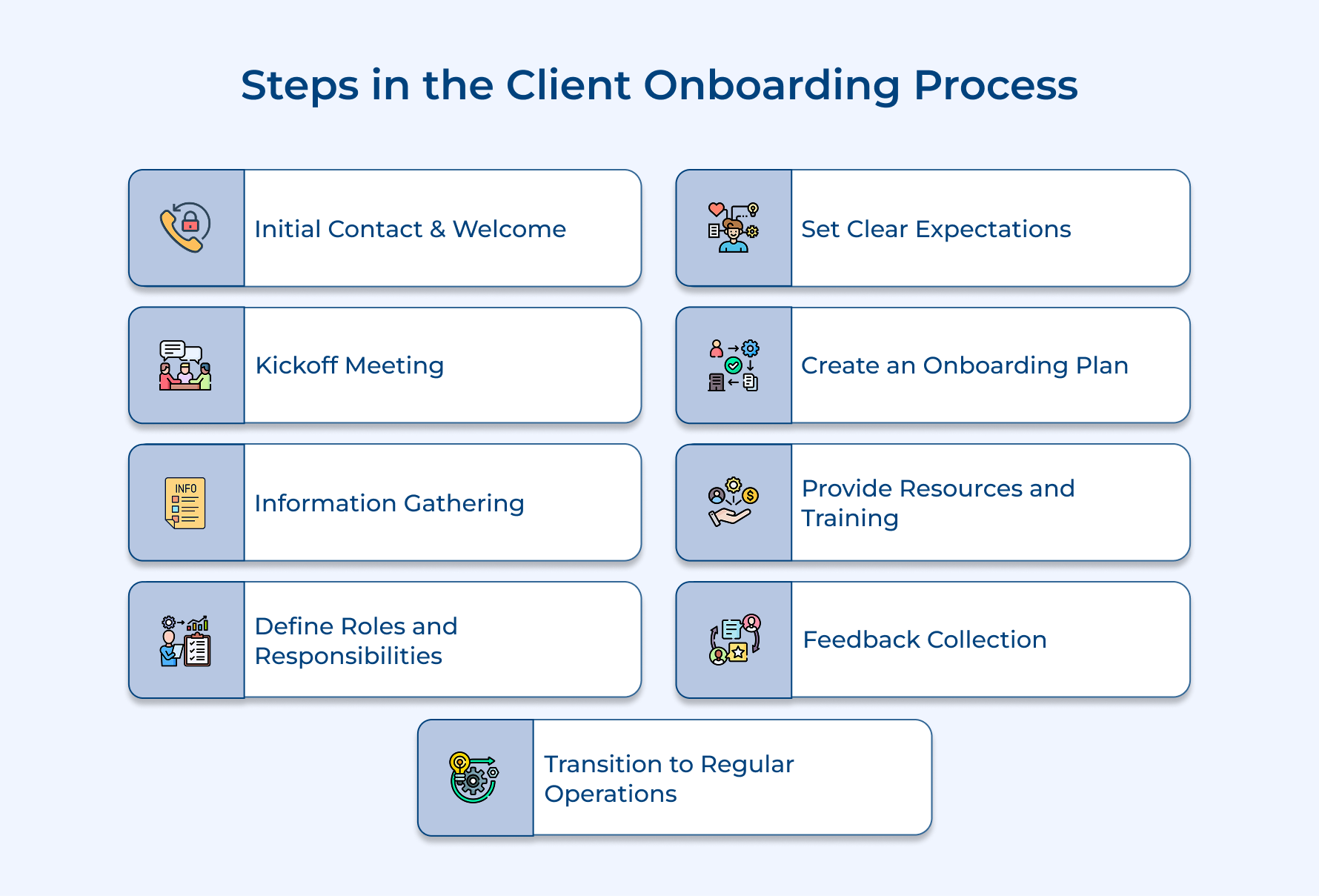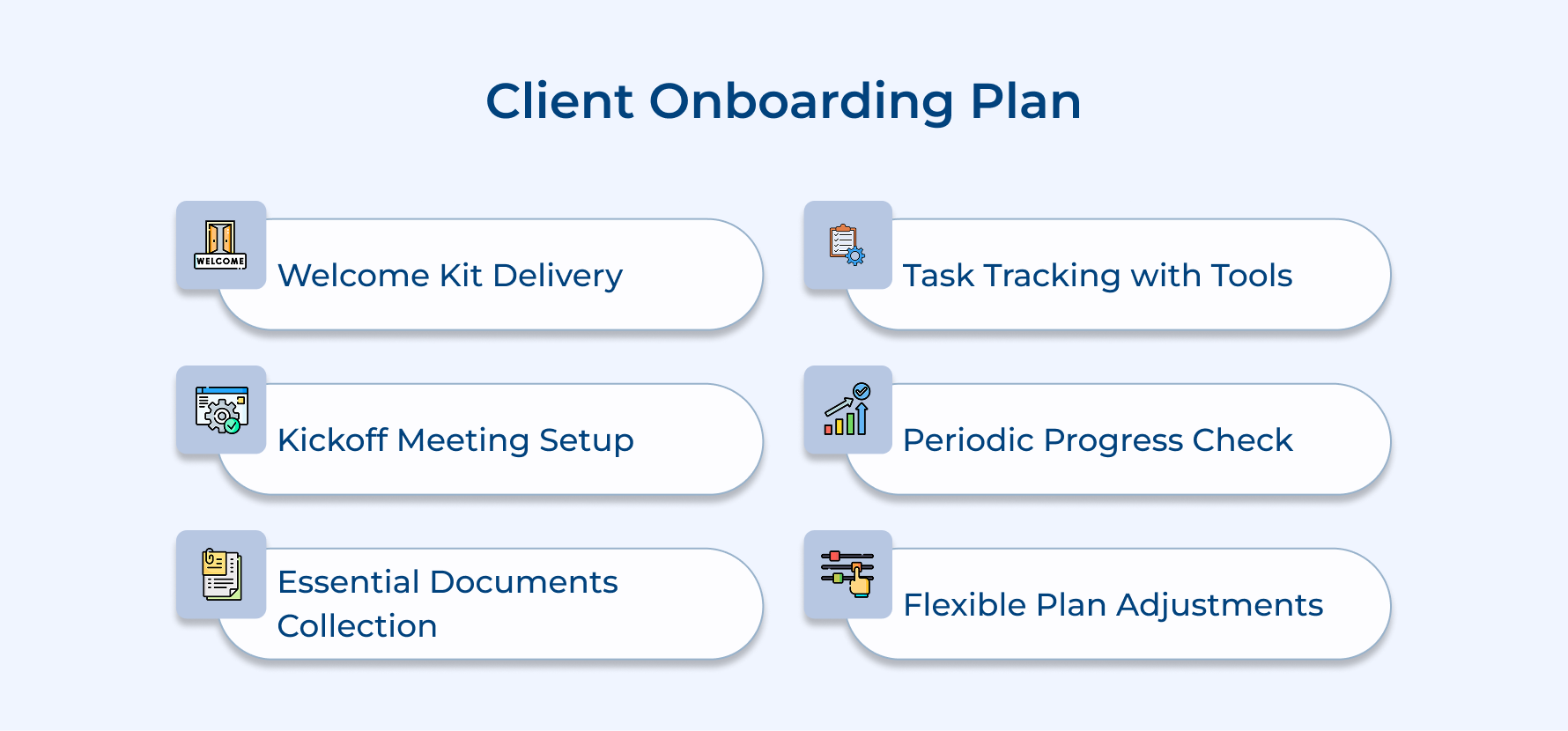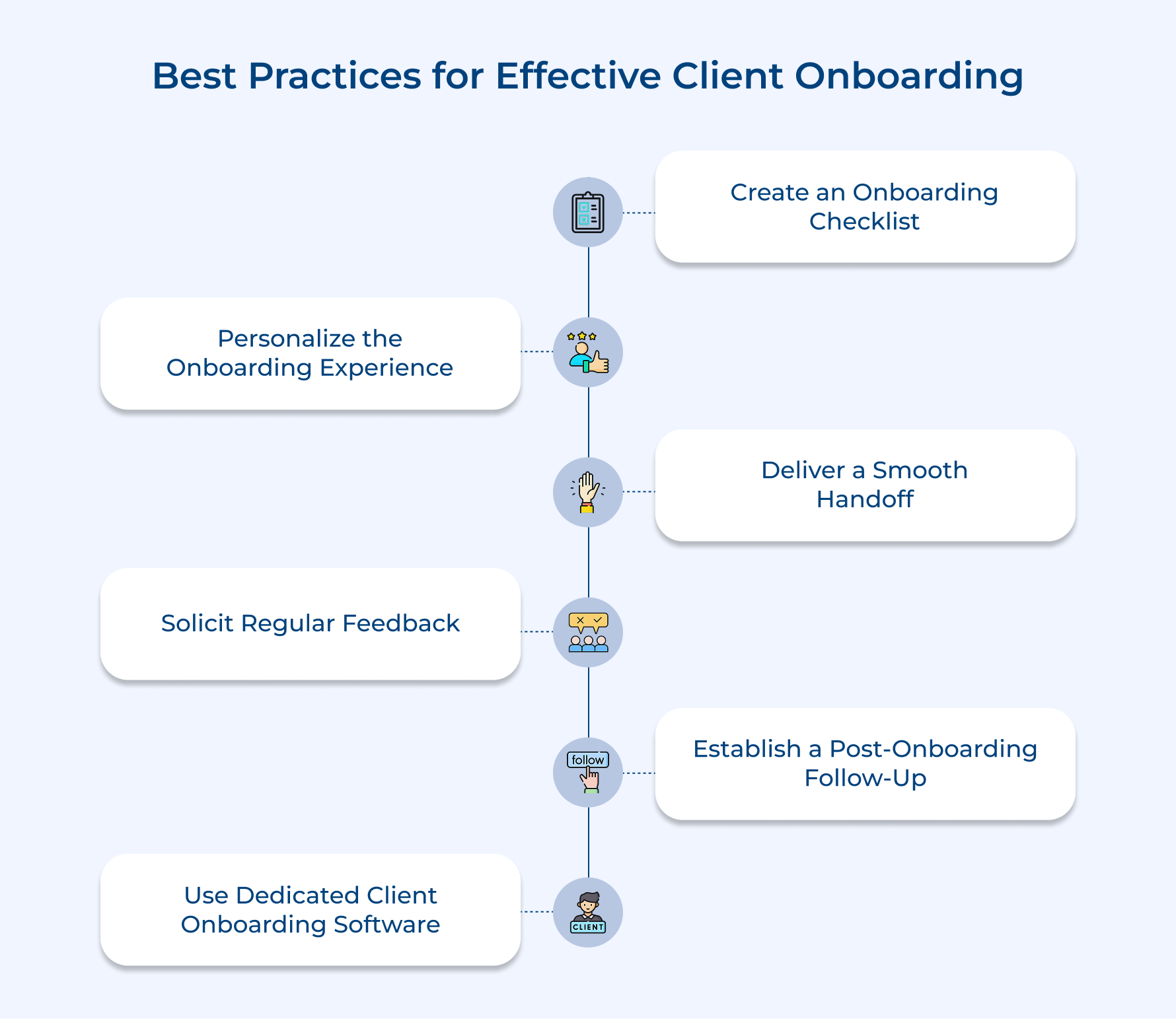9 Steps to Ace Client Onboarding and Win Over Clients
- What is Client Onboarding?
- Importance of Client Onboarding
- Key Steps for a Smooth Client Onboarding Process
- Examples of Successful Client Onboarding
- Measuring the Success of Client Onboarding
- Best Practices for Effective Client Onboarding
- Driving Agency Growth Through Effective Client Onboarding
- FAQs about Client Onboarding

Key Highlights:
- A strong client onboarding foundation reduces churn and builds lasting client relationships.
- Align expectations and project scope with a collaborative meeting to set the stage.
- Outline deliverables, timelines and communication protocols to avoid misunderstandings.
Let’s face it—client onboarding can sometimes feel like a juggling act. It’s easy for things to get overwhelming, and when that happens, new clients can end up feeling confused or frustrated. But here’s the thing: that first phase is so important.
A smooth, well-thought-out onboarding process doesn’t just make life easier for you—it makes your clients feel valued, informed, and confident from day one. It sets the tone for trust, loyalty, and collaboration.
We’re breaking down what makes an effective onboarding process while also sharing tips to help you create an experience that leaves your clients feeling excited and supported. Let’s get started!
What is Client Onboarding?
Client onboarding is the process of integrating new clients into a business or organization, ensuring they have a smooth and positive experience from the outset. It typically involves introducing clients to the company’s services, clarifying expectations, and establishing a strong working relationship.
A well-executed onboarding process enhances client satisfaction, setting the tone for future interactions. When clients feel informed during their initial experience, they are more likely to remain loyal and refer others.
Key objectives:
- Establishing clear communication channels: Ensuring clients know how to reach their contacts and access support builds transparency as well as trust from the beginning.
- Setting expectations: Outlining project timelines, deliverables, and objectives helps align both parties, reducing the likelihood of miscommunication or disappointment.
- Ensuring a smooth transition into services: Providing clients with a structured introduction to your services and processes minimizes confusion while enhancing their confidence in your capabilities.
Importance of Client Onboarding
Client onboarding is your chance to make a great first impression and set the stage for a strong partnership. Let’s explore other crucial reasons why it is important:
Improved Retention Rates
Strong onboarding foundations establish lasting client relationships, reducing churn rates significantly. Well-onboarded clients are more likely to stay with an agency, leading to increased lifetime value and stable revenue streams.
Expectation Management
Clear onboarding processes align objectives and set expectations from day one. Open communication about deliverables, timelines, and responsibilities ensures both parties work cohesively toward shared goals.
Streamlined Processes
Professional onboarding workflows create efficient systems that save time and resources. Standardized procedures help agencies scale operations while maintaining quality, reducing costs, and improving team productivity.
Positive Referrals
Smooth onboarding experiences directly influence client satisfaction, increasing service recommendations. Satisfied clients become natural brand advocates, generating valuable word-of-mouth referrals and compelling testimonials.
Gathering Valuable Insights
Strategic onboarding processes reveal detailed information about client needs, preferences, and goals. Collected data enables agencies to tailor services and anticipate future requirements with precision.
Risk Mitigation
A successful client onboarding process establishes communication channels, documents agreements, and sets clear boundaries. Proper documentation prevents scope creep, minimizes legal risks, and protects all involved parties.
Key Steps for a Smooth Client Onboarding Process
Getting your client onboarding process right doesn’t have to be complicated. Here’s a step-by-step guide to ensure every client feels welcomed, informed, and ready to dive in!
1. Initial Contact & Welcome
Your first interaction with a client sets the stage for the entire relationship. Make it count by:
- Demonstrating professionalism: Show clients you’re prepared—it builds trust and confidence.
- Setting clear expectations: Lay the groundwork for smooth communication and future interactions.
Make clients feel valued with a personalized touch:
What to include:
- Introductory materials about your company and team.
- A breakdown of the next steps.
- Key contact information for quick access.
Create a branded welcome kit with FAQs, necessary forms, and resources that clients can easily access online.
Keep things simple and effective from the start:
Automated welcome emails:
- Share key details like login credentials and initial action items.
- Highlight important next steps in a clear and friendly way.
Schedule early check-ins:
- Plan initial meetings to discuss expectations and gather input.
- Use preliminary questionnaires to understand your client’s needs better.
Use tools to monitor the completion of forms or access to digital kits for better follow-up.
2. Kickoff Meeting
Think of your kickoff meeting as the playbook huddle before the big game—it’s where everyone gets on the same page and gears up for success. Let’s say you’re onboarding a client for a website redesign. Here’s how to make that meeting count:
- Start with introductions: Kick things off by introducing your team members, like your project manager and lead designer, so clients know who’s who.
- Cover the essentials: Walk through the project scope, like redesign goals, timelines, and key deliverables—maybe a homepage prototype by week two.
- Clarify roles: Assign clear responsibilities to avoid confusion, like who’s approving the design drafts or providing the brand assets.
- Set expectations: Lay out communication protocols, such as weekly updates or preferred channels like Slack or email.
- Discuss success metrics: Define what “done” looks like—say, a 20% increase in website traffic within the first quarter post-launch.
3. Information Gathering
Let’s say you’re crafting a marketing strategy for a tech startup. You might begin by sending them a quick questionnaire to understand their target audience, competitors, and key objectives, like boosting brand awareness.
You could schedule a meeting with their CEO or marketing lead to dive deeper into their challenges. Maybe they’re struggling with inconsistent messaging or reaching the right audience. These conversations can reveal insights that form alone won’t capture.
Don’t forget to review any existing materials they have, such as past campaign data or analytics reports, to get a sense of what’s already working. By organizing all this information into a clear client profile, you’ll have everything you need to design a tailored solution while avoiding misalignment.
4. Define Roles and Responsibilities
When everyone knows exactly what they’re responsible for, things flow more smoothly, and expectations are managed on both sides. By defining roles early on, you can avoid those awkward moments and keep the project moving forward.
One way to do this is by creating a RACI matrix that outlines who’s Responsible, Accountable, Consulted, and Informed for each part of the project.
You can also document key contacts, escalation paths, and backup personnel, so there’s no scrambling if someone’s unavailable. And what about communication? Have you set clear channels and response time expectations, so everyone stays on the same page?
Pro tip: Visual role maps can be a lifesaver, giving a quick snapshot of responsibilities and reporting lines.
5. Set Clear Expectations
Clear expectations are the secret to smooth projects. They keep everyone on the same page, prevent misunderstandings, and give you solid benchmarks to measure success. Set the stage by:
- Outline deliverables and timelines: Use detailed service level agreements (SLAs) to specify what you’ll deliver when it’s due, and the quality standards you’ll meet. This helps avoid surprises later on.
- Map out the project milestones: Break the project into smaller goals with specific outcomes, so it’s easy to track progress and celebrate wins along the way.
- Establish communication protocols: Decide how you’ll stay connected—email, Slack, or meetings—and set clear response time expectations to keep things moving.
6. Create an Onboarding Plan
A solid onboarding plan keeps everything on track and ensures a smooth journey for both you as well as your client. How to make it work, you ask?
Develop a timeline-based checklist:
- Outline all onboarding activities, deliverables, and key milestones.
- For example, include steps like sending the welcome kit, hosting the kickoff meeting, and collecting essential documents.
Use project management tools:
- Platforms like Asana or Trello are great for tracking progress, assigning tasks, and sending automated reminders.
- This keeps everyone accountable and avoids tasks slipping through the cracks.
Review and adapt the plan regularly:
- Schedule periodic check-ins to make sure things are progressing as planned.
- Be ready to adjust if priorities shift or unexpected challenges arise.
Create a plan you can easily tweak based on the client’s needs and the complexity of services. Always add buffer time to accommodate delays or additional client requests.
7. Provide Resources and Training
Giving your clients the right training and resources helps them make the most of your services, reduces their need for constant support, as well as builds their confidence in using your tools.
Think about it: the more capable they feel, the more likely they are to see value quickly and stick around for the long haul.
Start by creating easy-to-follow training materials like video tutorials, user guides, and step-by-step documentation. Host tailored training sessions that match their skill levels, whether they’re beginners or seasoned pros.
Don’t forget to give them access to a well-organized resource library filled with searchable content and answers to common questions. The easier you make it for them to learn, the stronger your partnership will be!
8. Feedback Collection
Feedback is your secret weapon for ensuring clients are happy and your customer onboarding process stays top-notch. It’s how you catch issues early, make adjustments, and show clients that their opinions matter. Here’s how to get started:
Use surveys to check the pulse:
- Keep it short and focused—maybe ask how they felt about the kickoff meeting or the clarity of your training materials.
Schedule regular check-ins:
- How often do you touch base with clients to get their thoughts? A quick chat can reveal insights that surveys might miss, giving you a clearer picture of their experience.
Leverage automation for efficiency:
- These can help you spot patterns, like a recurring issue with communication or a particularly helpful resource that clients love.
9. Transition to Regular Operations
With clear transition protocols in place, you can prevent service gaps and ensure everything stays on track.
Start by creating a detailed transition checklist that covers all handover requirements. Then, schedule a formal transition meeting to celebrate achievements, review ongoing support processes, and introduce the regular service team.
To make the transition even smoother, prepare a comprehensive document that outlines normal operating procedures, key contacts, and escalation paths.
Don’t stop there—schedule a 30-day post-transition review to check in with the client and ensure all systems as well as processes are running smoothly.
Examples of Successful Client Onboarding
Let’s take a look at two examples of client onboarding done right. These real-world success stories show how the right approach can lead to happy clients and smooth partnerships.
Slack’s Interactive Welcome Tour
Slack transformed complex team communication software adoption into an engaging experience. Their onboarding focused on immediate value demonstration through interactive tutorials and gradual feature introduction, resulting in a 93% user retention rate.
Key Implementation Elements:
- Created a friendly chatbot “Slackbot” that guides new users through basic features
- Implemented progress bars and checklists to track onboarding completion
- Sent targeted tips based on user behavior and role within the organization
Shopify’s Merchant Success Program
Shopify revolutionized e-commerce onboarding by combining personal support with automated guidance. Their approach helped new merchants launch stores 70% faster than self-guided setups.
Key Implementation Elements:
- Assigned dedicated Merchant Success Managers for the first 45 days
- Provided customized setup checklists based on business type
- Offered milestone-based rewards and recognition for completion
Measuring the Success of Client Onboarding
Tracking onboarding success is essential for continuous improvement. Metrics provide insights into effectiveness and client satisfaction. Here are the metrics to consider.
Client Satisfaction Surveys
Regular surveys capture direct feedback about the onboarding experience. Post-onboarding questionnaires measure satisfaction levels, identify pain points, and gather suggestions for improvement. Net Promoter Scores (NPS) indicate the client’s likelihood to recommend services.
Retention Rates
Tracking client retention during and after onboarding reveals process effectiveness. Successfully onboarded clients typically show higher retention rates within the first 90 days. Monitor churn rates and reasons for early contract terminations.
Engagement Metrics
Monitor client participation in onboarding activities, resource utilization, and response rates. Track platform logins, document completion rates, and attendance at training sessions. High engagement typically correlates with successful long-term relationships.
Time to Onboard
Measure the duration from contract signing to full-service implementation. Track milestone completion speeds, identify bottlenecks, and compare actual timelines against planned schedules. Efficient onboarding reduces time-to-value.
Financial Metrics
Evaluate implementation costs, resource allocation, and early-stage revenue generation. Monitor project profitability during the onboarding phase, track additional service requests, and measure initial revenue acceleration post-onboarding.
Analysis of Common Issues
Document recurring challenges, support ticket patterns, and frequently asked questions during onboarding. Use data to identify process gaps, improve documentation, and enhance training materials for future clients.
Best Practices for Effective Client Onboarding
Implementing best practices can significantly enhance the onboarding experience. These strategies build stronger client relationships and improve retention. Here are the best practices to adopt.
Create a Comprehensive Onboarding Checklist
Develop a detailed, phase-by-phase checklist covering all onboarding elements. Include task owners, deadlines, and dependencies. Regular checklist reviews ensure nothing falls through the cracks and maintain consistent service delivery standards.
Personalize the Onboarding Experience
Customize onboarding processes based on client size, industry, and specific needs. Adapt communication styles, training materials, and resources to match client preferences. Create tailored milestone plans reflecting unique business objectives.
Deliver a Smooth Handoff
Ensure seamless transitions between sales, onboarding, and account management teams. Share critical client information, document specific requirements, and maintain clear communication channels. Schedule proper handoff meetings involving all relevant stakeholders.
Solicit Regular Feedback
Implement structured feedback collection at key onboarding stages. Use surveys, check-in calls, and progress reviews to gather insights. Address concerns promptly and adjust processes based on client input.
Establish a Post-Onboarding Follow-Up
Schedule systematic follow-ups after onboarding completion. Review goal achievement, address outstanding issues, and gather insights for process improvement.
Use Dedicated Client Onboarding Software
Deploy specialized onboarding tools to automate workflows, track progress, and maintain documentation. Utilize features like automated reminders, progress tracking, and client portals to streamline the entire process.
Driving Agency Growth Through Effective Client Onboarding
Effective client onboarding significantly impacts the establishment of strong, lasting relationships within professional services. A well-structured onboarding process enhances client satisfaction, improves retention, and builds open communication. Personalizing the experience while also utilizing technology ensures clients feel valued and supported from the outset.
Continuous improvement of onboarding practices boosts client confidence and lays a solid foundation for successful collaborations. Actively seeking feedback helps identify areas for enhancement, ensuring the process remains relevant and effective.
Investing time and resources into a thoughtful onboarding process yields substantial dividends in client loyalty as well as business growth. The focus makes onboarding an essential component of any agency’s success strategy.
Limit time — not creativity
Everything you need for customer support, marketing & sales.
Neeti Singh is a passionate content writer at Kooper, where he transforms complex concepts into clear, engaging and actionable content. With a keen eye for detail and a love for technology, Tushar Joshi crafts blog posts, guides and articles that help readers navigate the fast-evolving world of software solutions.



